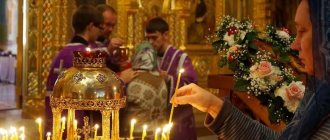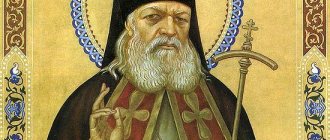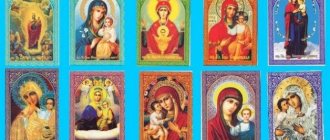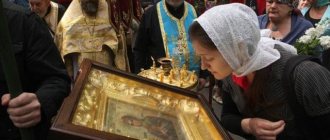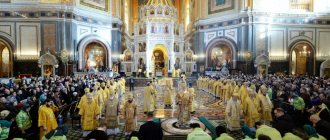History of tradition
The custom of lighting a fire during worship came to us from paganism. When Christianity first began to emerge, it adopted this tradition. However, at that time it was rather a necessary measure, because the followers of the teachings of Christ were hiding from persecution in underground caves.
The use of oil lamps was first mentioned by the martyr Cyprian. The Book of Genesis says that the Almighty ordered Moses to place seven candles in a golden candlestick during sermons as a sign that the light of God was breaking through sinful darkness. Later, when the Gospel appeared, the priests preceded the removal of the Holy Scriptures with a lit fire, symbolizing the enlightenment of worldly souls.
The custom of lighting a fire during worship came to us from paganism.
Officially, candles became an attribute of the church only with the advent of Emperor Constantine. In the 4th century they were used during funeral services for the deceased, and a hundred years later they began to be used everywhere. If we talk about symbolism, there are several interpretations:
- melting wax represents a soul melting from repentance;
- a lit candle is a sign of acceptance of God's will;
- the plasticity of the material from which it is made symbolizes the soul being reborn in Christ;
- a burning flame is a symbol of faith and hope in the Almighty.
When did the tradition begin?
Even in the Old Testament, the Lord commands Moses to make a lamp of gold with seven lamps “Menorah”. Subsequently, the priests performed divine services by burning candles. The prophet David calls God a lamp that leads man to eternal life.
Lamps were used by the holy apostles and the first Christians, who had to hide to perform prayer and the Eucharist . The custom of lighting candles in churches came to Russia from Greece, from where Saint Prince Vladimir adopted the Orthodox faith.
How and when to light candles
Crossing the threshold of the church, a person submits to certain canons and rules that reign in the Temple of the Lord. In order not to disturb the established order, you need to know the sequence of the ritual:
- first they approach the Life-Giving Cross, bow their heads, read a prayer, and then light a fire near it;
- then they follow to the lectern, where they sign themselves with the sign of the cross, bow twice, put their lips to the holy image and bow again;
- then they go to the main candlestick, say a prayer, after which they light the candle, crossing themselves;
- The ritual is completed by lighting a fire near the icons of Christ the Savior, the Mother of God and the main image of the temple.
You should not use lamps to light the lamps, as there is a risk of extinguishing them. Also, do not tilt the lit candle so that hot wax does not flood the candlestick. After completing the obligatory ritual, you can go to other shrines of the church to light candles in their glory. It doesn’t matter to whom the prayer will be addressed, the main thing is to do everything with an open heart and pure thoughts.
For your health
For prayers for health, there is a round candlestick in the church, where candles should be placed for living relatives and friends, or for one’s enemies. Approaching the chosen image, they say a prayer, make the sign of the cross, and then light the fire. An appeal to a saint must be sincere, otherwise the request will not be heard.
There is a round candlestick in the church for prayers for health
It is right to pray to your Guardian Angel for health. It is his laity who ask him to intercede for them before the Almighty. At the same time, they always address the heavenly warrior by name: “Holy Angel of God (name), pray before the Lord for me.”
When lighting candles for your ill-wishers, you need to ask God to save their souls, but you cannot keep resentment or anger towards your enemies in your heart.
Author's advice
For your peace
After praying for the living, we should remember the dead. For this purpose, a rectangular candlestick called a kanun is located in the temple near the entrance. Near it there will definitely be a small table where donations for remembrance are placed. It is here that funeral services are held on Saturdays. The ritual begins with the sign of the cross, and in their address they list everyone who has gone to Heaven. Next, light the candle and place it in the socket on the candlestick.
If the fate of a person is unknown, a prayer for his repose is not read. They ask for him as if he were alive, so that the Creator Himself would decide his fate. You also cannot light a candle for a dead person who has passed away voluntarily. Praying for suicides in church is a great sin, because a person kills the Holy Spirit with his own hands. However, the church does not prohibit doing this at home, so that the mourner has a chance to beg the Almighty for forgiveness for the deceased.
Candles for the repose are placed in a rectangular candlestick - eve
The symbolism of a church candle
For the first Christians, lamps personified the light of Christ's faith, and made it possible to illuminate the location. In the age of electricity, a candle has become a shrine that has spiritual and symbolic meaning.
A church candle embodies:
- a sacrifice to the temple in which it is bought;
- the prayer of a believing heart;
- love and warmth for the Lord, the Mother of God, Angels, saints;
- gratitude to the Savior for the sacrifice on the cross;
- a Christian's desire for spiritual transformation.
At a service, candles signify Christ himself, His sermon. Earthly light is a prototype of Heavenly Light. Candles are used in many Sacraments: baptism , wedding , unction . At a deep level, she represents the most believing person, who burns with Christ and is a kind of lamp for his neighbors.
Which saint should I light candles in church?
A person who comes to a temple does not always know which face to address with his request. There is no universal icon that would fulfill all wishes, and therefore you need to know which image to approach.
About remission of sins
- Jesus Christ;
- Blessed Virgin Mary;
- saints who are your intercessors.
For family well-being
- Ksenia Petersburgskaya;
- John the Theologian;
- "Softening Evil Hearts";
- other icons of the Mother of God.
For marriage or marriage
- Nicholas the Wonderworker;
- Ksenia Petersburgskaya;
- "Fadeless color";
- Paraskeva Friday.
When cheating
- "Recovery of the dead";
- John Chrysostom;
- Silouan of Athos.
To conceive a child
- Ksenia Petersburgskaya;
- Seraphim of Sarov;
- Mother of God icons.
Get well soon
- Jesus Christ;
- Most Holy Mother of God;
- healer Panteleimon;
- Saint Luke of God.
Jesus Christ
Holy Mother of God
Healer Panteleimon
Before surgery
- "Savior Almighty";
- Luka Krymsky;
- healer Panteleimon.
To relieve alcohol or drug addiction
- "Inexhaustible Chalice";
- Matrona of Moscow;
- John of Kronstadt;
- Nicholas the Wonderworker.
For good studies
- "Key of Understanding";
- “Increasing intelligence”;
- "Upbringing";
- Sergius of Radonezh;
- John of Kronstadt;
- Matrona of Moscow;
- Nikolai Ugodnik;
- Ksenia Petersburgskaya.
For search and success in work, business, trade
- Spyridon of Trimifuntsky;
- Nikolai Ugodnik.
For material wealth
- Nicholas the Wonderworker;
- Spyridon of Trimifuntsky.
Icons of St. Nicholas the Wonderworker are asked for material wealth
Donation
In general, most church ministers urge the laity not to give a candle more importance than it really deserves. It is better to pay enough attention to the prayer itself. The fact is that, according to the priests, buying a candle is, first of all, a voluntary donation to God and the temple. The money raised from the sale of various church paraphernalia goes to repair and maintain religious institutions, to pay salaries to their employees, to help those in need, etc.
That is why priest Svyatoslav Shevchenko on the website of the Orthodox magazine “Thomas” answered one of the readers’ questions about candles this way: “The matrix of commodity-money relations cannot be used to communicate with God. He doesn’t care how many or how thick the candles are.” The priest assured the parishioner that he could light as many candles as he saw fit, or he could pray without them at all. According to the clergyman, God only cares about our warm and sincere heart.
Folk superstitions
Along with the tradition of lighting a fire in the temple, many prejudices associated with this ritual have come to us. Modern theologians call to avoid them, but many believers still follow these superstitions. For example, lighting a candle for repose, if a person is still alive, is considered a manifestation of black magic. Yes, the church interprets such an action as a terrible sin, but this has nothing to do with witchcraft.
To find happiness, you need to light twelve candles in twelve churches and read the spell three times in front of the icon of the saint. It is good if the ritual is accompanied by chants.
Despite the negative attitude of Orthodoxy towards the interpretation of dreams, many Christians consider it a bad sign if they dreamed that they were lighting a candle on the ruins of a church. But visiting a monastery in a dream is interpreted as God’s blessing. However, theologians urge not to follow the lead of dream books, since any dream can be explained from different points of view and humans have no right to interfere with the Will of the Lord.
Today it is difficult to imagine the Temple of the Lord without lit candles and lamps. The burning fire became a symbol of the church, like the Light of God illuminating sinful darkness. That is why, when praying for protection or asking for blessings, Orthodox Christians place candles in front of the holy faces so that the Almighty will hear their request.
If you find an error, please select a piece of text and press Ctrl+Enter.
A candle is a symbol
Once upon a time, candles, both in people's homes and in churches, were used exclusively for their intended purpose - they illuminated the room in the dark. At first, lamps predominated in churches. The Lord himself ordered Moses to make such a lamp. However, gradually the candle became not so much a source as a symbol of light, which is associated primarily with a good, good beginning. “I am the light of the world,” says Christ on the pages of the Gospel (John 29, 8, 12-20).
Based on the above, it follows that the candle is not at all a symbol of the human soul. According to Priest Alexander Beloslyudov (the “Law of God” website), a candle is a symbol of prayer. However, according to the priest, her flame does not at all replace turning to God. Candles, however, like icons and lamps, only set the parishioner in the right mood.
For health and peace
Thus, it turns out that it doesn’t matter how many candles and for how many people you put in the church, the main thing is your sincere prayer. But what about the candles that are lit for the health of the living and for the repose of the dead? After all, traditionally for funeral candles in most churches there is a special memorial table - eve. Therefore, many people think that one candle cannot be used for 2 different purposes. In fact, this is far from the case.
The online publication “Orthodoxy and the World,” with reference to the magazine “Thomas,” reports that a candle, as a symbol of prayer for the departed or living, can be lit on absolutely any stand. However, Archpriest Igor Fomin still calls on believers to adhere to the established order whenever possible and still use the eve to pray for the repose of the souls of the dead.
Candle in the temple: meaning and meaning
But there is never complete darkness: “The light shines in the darkness.” But during holiday and Sunday services, all the lamps are lit according to order, including the upper ones - the chandelier and the chandelier, creating an image of that full light of God that will shine for the faithful in the Kingdom of Heaven and is already contained in the spiritual meaning of the celebrated event.
The symbolic nature of light in the church is also evidenced by the design and composition of burning candles and lamps. Wax
and
oil
in ancient times were offerings of believers to the temple as voluntary sacrifices. The 15th-century liturgist Blessed Simeon, Archbishop of Thessaloniki, explaining the symbolic meaning of wax, says that pure wax means the purity and innocence of the people bringing it. It is offered as a sign of our repentance for perseverance and readiness to continue to obey God, like the softness and pliability of wax. Just as wax produced by bees after collecting nectar from many flowers and trees symbolically means an offering to God as if on behalf of all creation, so the burning of a wax candle, like the transformation of wax into fire, means deification, the transformation of earthly man into a new creature through the action of fire and warmth of Divine love and grace.
Oil, like wax, also signifies the purity and sincerity of a person in his worship of God. But oil also has its own special meanings. Oil is the oil of the fruits of olive trees, olives. Even in the Old Testament, the Lord commanded Moses to offer pure oil without sediment as a sacrifice to God (Ex. 27:20). Testifying to the purity of human relationships with God, oil is a sign of God’s mercy towards people: it softens wounds, has a healing effect, and approves of food.
Lamps and candles have great liturgical and mysterious significance. They burn in the altar behind the throne in a special lamp (seven-branched candlestick); a lamp or candle in a candlestick is placed in the High Place, on the throne, on the altar; lamps can also be lit near individual icons in the altar.
In the middle part of the temple, lamps are usually lit near all icons, and several lamps are lit near especially revered icons; in addition, large candlesticks with cells for many candles are placed so that believers can place the candles they bring to these icons here. A large candlestick is always placed in the center of the temple on the eastern side of the lectern, where the icon of the day lies. A special candlestick with a large candle is brought out at the small entrances during vespers and liturgy, at the great entrance during the liturgy, and also in front of the Gospel when it is brought out at the entrances or for reading. This candle symbolizes the light of Christ's preaching, Christ Himself, as Light from Light, the true Light. The candle in the candlestick has the same meaning, with which, together with the censer during the Liturgy of the Presanctified Gifts, the priest blesses the people with the words “The Light of Christ enlightens everyone.” Candles in bishop's dikirias and trikirias have special spiritual significance. During the censing of the church in statutory cases, the deacon precedes the priest performing the censing with a special deacon’s candle, which marks the light of the apostolic sermon preceding the acceptance of faith in Christ among the peoples, that is, as if preceding Christ coming to people.
Lighted candles are held in the hands of priests in the cases of worship provided for by the Charter. The priest uses a special lamp with three candles to bless the people during Easter services.
In the central part of the temple, a large lamp with many lights, lit on appropriate occasions, descends from the dome downward - a chandelier, or chandelier. From the domes of the side aisles, similar smaller lamps, called polycandiles, descend into the temple. Polikandils have from seven to twelve lamps, chandeliers - more than twelve.
Church lamps are different. Candlesticks
of all kinds, in addition to their practical purpose, they symbolize that spiritual height, thanks to which the light of faith shines on everyone in the house, on the whole world.
The chandelier
(multi-candlesticks, translated from Greek), descending from above into the central part of the temple, and
the polykandila
, located in the side chapels, with their multitude of lights signify the Heavenly Church itself as a collection, a constellation of people sanctified by the grace of the Holy Spirit, enlightened by the light of faith, burning with the fire of love to God, abiding inseparably together in the light of the Kingdom of Heaven. Therefore, these lamps descend from above into that part of the temple where there is a meeting of the earthly Church, called to spiritually strive upward, to its heavenly brothers. The Heavenly Church illuminates the earthly Church with its light, drives away darkness from it - this is the meaning of the hanging chandeliers and chandeliers.
On the iconostasis and in front of almost every icon case in the temple there is one or more lamps hanging, and there are candlesticks with burning candles. “The lamps burning in front of the icons mean that the Lord is an unapproachable light and a consuming fire for unrepentant sinners, and for the righteous a cleansing and life-giving fire; that the Mother of God is the Mother of light and the purest light Herself, unflickering, shining throughout the entire universe, that she is a burning and unburnt bush, which has unburntly received into Herself the fire of the Divine - the fiery throne of the Almighty... that the saints are lamps burning and shining throughout the whole world with their faith and virtues...
Candles in front of the icons of the Savior mean that He is the true Light, enlightening every person coming into the world (John 1:9), and at the same time the Fire that consumes or revives our souls and bodies; candles in front of the icons of the Mother of God mean that She is the Mother of unapproachable Light, and at the same time fiery love for the human race; that She carried the fire of the Divine in her womb and is unburnt and eternally carries within Her the fire of the Divine that has taken possession of Her; candles in front of the icons of saints mean the saints’ fiery love for God, for whose sake they sacrificed everything that is dear to a person in life... they mean that they are lamps that burn for us and shine with their lives, their virtues and our ardent prayer books before God, day and night those praying for us; burning candles signify our ardent zeal for them and heartfelt sacrifice...” (St. John of Kronstadt).
The lamp hanging in front of the icon symbolizes the ancient pillar of fire that Israel brought out in the night.
Candles burning on a candlestick, placed around a lamp, remind the person praying of the bush, of the thorn bush, which burned but was not consumed, and in which God appeared to Moses. The burning but not burning bush especially typified the Mother of God.
The candles, placed in regular circles, represent the chariot that delighted Elijah, and the circles themselves depict the wheels of this chariot.
“The fire of burning... candles and lamps, like the censer itself with hot coals and fragrant incense, serve for us as an image of spiritual fire - the Holy Spirit, who descended in tongues of fire on the apostles, burning away our sinful defilements, enlightening our minds and hearts, igniting our souls the flame of love for God and for each other: the fire in front of the holy icons reminds us of the fiery love of the saints for God, because of which they hated the world and all its delights, all untruths; It also reminds us that we must serve God, pray to God with a fiery spirit, which for the most part we do not have, for we have cold hearts. “So in the church everything is instructive and there is nothing idle or unnecessary” (St. John of Kronstadt).
Based on the book “Admonition to the Orthodox Christian about the Church Candle” from the Moscow Metochion of the Holy Trinity Lavra of St. Sergius.
back
What does a candle mean in an Orthodox church?
- A candle is not just a material sacrifice to God, it has a spiritual meaning.
- A candle is lit in front of the icon in addition to the prayer, making up for the lack of burning of our soul - as if as a sign of repentance for an insufficiently fiery prayer.
- The wax from which candles have always been cast is a gift from nature, brought by bees, so when we buy a candle in a temple, we also bring a small sacrificial gift.
- The candle also symbolizes a person who, being initially hard and cold, under the influence of the grace of Divine fire warms up, softens in soul and becomes pliable to God’s will.
Why do they light candles in churches?
A candle is placed next to an icon for a reason, but as a prayer to God and the saints. You cannot ask for obviously sinful things, for things that can bring trouble to other people, for everyday little things.
The candle is lit:
- simply in gratitude to God and the saints (a reasonable person, capable of comprehending his life, understands that there is always something to thank for);
- on church holidays to the festive icon;
- when they make a request to God, the Virgin Mary and the saints for health, a safe journey or solving everyday affairs;
- for the repose of the soul of the deceased.
Light a candle in the temple on the Svyatsy website online.
How to light candles in church and what to say when doing so
The rules of decorum do not approve of disorderly behavior in the temple. If you had to be late, you shouldn’t wander around the temple, push your way to the icons, or pass candles. You need to wait until the end of the service and then, without distracting others, light the candles and pray.
The order in which the candles are placed matters. First, the candle is lit at the festive icon in the center of the temple in front of the altar, then to the Lord Jesus Christ and the Most Holy Theotokos. There is only one Mother of God, there are only many images of her, so you can choose any icon.
Approaching the image, you need to bow twice with a bow from the waist, as if you wanted to reach the floor with your fingers. After this, go to the icon, say a prayer, kiss it and light your own candle from the one next to it - it is not customary to light it from a lamp. Before leaving, bow a third time.
But most importantly, you need to remember that the candle and prayer are addressed not to the icons, but to those who are depicted on them. At the same time, it is customary to address the Creator with the words “Lord, have mercy on me (us),” and to the Mother of God – “Most Holy Theotokos, save me (us).”
How and where to light a candle for repose
It can be found on the left side, closer to the entrance.
This is a large table with a candlestick in front of the Crucifixion, at which memorial services are held.
They ask for repose both in their own words and in prayer: “Have mercy, O Lord, on your departed servant ___ (say the full name given at baptism), forgive all his sins, voluntary and involuntary, and grant him the Kingdom of Heaven.” It must be remembered that candles are not lit in church and prayers are not offered for suicides and the unbaptized.
How and where to light a candle for health in church
- Everywhere, except on the eve, candles are lit for health.
- In other words, you can pray for the living - for their well-being, physical and spiritual health and light candles at any icon, turning mentally to the one depicted on it.
- Candles are placed in front of any images of the Savior and the Most Holy Theotokos, the patron saint after whom a person is named at baptism, Archangel Michael, as well as saints to whom one would like to turn in prayer at the moment.
Which icon should I light a candle for health in front of?
Sometimes it is necessary to pray specifically for a person’s health, for which it is customary to turn to the icons of the Mother of God, which have a special history of healing from certain diseases.
The name will be suggested in the temple: for example, “Three-handed”, “All-Tsarina”, “Healer”.
They ask their Guardian Angel and saints who were doctors during their lifetime for health. This is the healer Panteleimon, St. Luke of Crimea, St. Agapit, holy unmercenary doctors Cosmas and Damian, Cyrus and John.
How to light a candle for the Guardian Angel
At birth, a person is given a Guardian Angel, who accompanies him during life and during the transition to another world. In the temple a candle is lit to the Holy Archangel Michael, the military leader of the angelic heavenly forces - all angelic ranks are honored in his person.
On the icon he is usually depicted in armor, with a shield and a fiery sword in his hands.
The saint in whose honor a person is given a name is considered his second Angel. There are usually no problems with finding an icon of a saint, but if the name is rare, then you can turn to it in front of the icon of All Saints.
What should you say? During prayer, it is customary to address saints and angels not as God, but as intercessors: “Holy Martyr Tatiana, pray to God for me,” “Holy Angel of God, my Guardian, pray to God for me.”
Which saint should I light a candle for work and success in business?
The saints, having pleased God, often asked Him to be given the right to help people in certain needs. But the prayer may remain unanswered - it depends on what you say in front of the icon. Perhaps fulfilling what a person wants will not be useful.
Before what images can you pray for well-being and success in business:
- Traditionally, in Rus' people most often ask for help from St. Nicholas the Wonderworker;
- Parents pray to St. for the prosperous life of their children. Mitrofan of Voronezh;
- John the New is asked for success in trade;
- people turn to the blessed Matrona of Moscow and Ksenia of St. Petersburg, the martyr Tryphon and other saints for help in various everyday issues.
Is it possible to light a candle for the repose of an unbaptized person?
The Church does not pray for the unbaptized. People who during their lifetime did not want to become part of a single church body remain outside it even after death.
Seeds can be thrown into the ground, watered and fertilized, and those that contained life will sprout, and those that were dead will remain in their previous state. So are the dead - if during their lifetime they strived for God, through the prayers of their loved ones they will be given a better fate. What if during earthly life they were already spiritually dead, rejecting the Church and God?
It is worth noting: it is allowed to pray for such people in home prayer.
In Orthodoxy, the concept of love between a man and a woman is applicable only to a married marriage. Anything else is considered a sin, so there is no need to light candles for good luck in love. Therefore, there are only two types of prayer - for finding a spouse, or for love and peace in the family.
For the acquisition of the second half they pray to the holy blessed Matrona of Moscow, Xenia of St. Petersburg, St. Nicholas the Wonderworker, Holy Great Martyr Catherine, Guardian Angel.
They ask for love in the family to the righteous princely couple Peter and Fevronia, the holy martyrs Tsar Nicholas and Tsarina Alexandra, who became models of loving and devoted spouses, and the holy martyrs Adrian and Natalia.
Is it possible to light a candle for your health?
Only saints in earthly life had the spiritual strength to beg others. St. Seraphim of Sarov said: “Save yourself, and thousands will be saved around you.” Therefore, a person is called to pray, first of all, for the salvation of his soul.
And for your prayer to be heard, you need to reconcile with everyone, sincerely forgive and pray for the health of your enemies.
Which saint should I light a candle for studying?
If you don’t have enough strength to independently master new knowledge, pass an exam, or solve a difficult life problem, turn to the image of the Most Holy Theotokos “Adding the Mind.”
